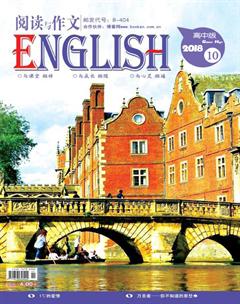万圣夜
如果你住在外国,每年10月31日晚上,当你看到人们穿上夸张的服饰,化着僵尸妆或鬼怪妆,头上再插把匕首什么的——总之越惊悚越夸张越好——你就知道,万圣夜来了!这几年,万圣节在中国也开始流行起来:万圣节服装热卖,万圣夜派对遍地开花;尤其是主题公园,要是不在当天推出一两个精心策划的万圣节活动,别人还以为贵公园已经关门谢客了呢。
对于这么一个热闹的节日,你对它的认识有多少?你知道吗,万圣夜(Halloween)意为“万圣节前夜”,中文却经常直接称为万圣节,这是不正确的哦。我们打赌,关于万圣夜,有很多事情是你不知道的——
When most people think of Halloween, they think of trick—or—treating, parades[游行], bobbing[咬住悬挂物] for apples, and other family friendly activities. But, bet you didnt know the true story behind the ancient origins[起源] of Halloween.
It all goes back some 2,000 years to the ancient Celtic festival known as Samhain, celebrated on November 1st. On the night before Samhain, people believed that the dead returned as ghosts. They would leave food and wine on their doorsteps to keep roaming spirits at bay[阻止……前进], and wear masks when they left the house so they would be mistaken for fellow ghosts.
The Christian church turned Samhain into All Saints Day, or All Hallows, in the 8th century. The night before became All Hallows Eve, later shortened to Halloween. Youve heard of trick-ortreating on Halloween, but what about “souling”or “guising[伪装]”? All three of these traditions originated in Medieval Britain.
On All Souls Day, November 2nd, the needy would beg for pastries[酥皮糕点] known as soul cakes. In return, they would pray for peoples dead relatives. This was called “souling.”
In the Medieval Halloween tradition of “guising,”young people would dress up in costume and accept food, wine, money and other offerings in exchange for singing, reciting poetry or telling jokes.
In 19th century America, Irish and Scottish immigrants[移民] revived[使復兴] these old traditions. The result was trick-or-treating. At first it was much more about the tricks, in the form of pranks[恶作剧] and hijinks[喧闹的玩乐], than the treats. It wasnt until the 1950s that the custom took on its current familyfriendly kid-centered form.
Today, Halloween is big business, with US consumers[消费者] spending more than 2.5 billion on costumes annually[一年一次]. Add in the candy and its estimated[估计] that Americans spend up to six billion on Halloween each year, making it the second-most commercial[商业的] holiday after Christmas.
So whether youre a fan of tricks, treats or trivia[琐事], theres a bit of Halloween history…we bet you didnt know. (laughing)
大多数人一想到万圣夜,就会想到“不给糖就捣乱”、游行、咬苹果游戏,以及其他适合一家人玩的活动。然而,我们敢打赌,你不知道万圣夜古老起源背后的真实故事。
一切要回到两千年前那个古老的凯尔特节日——在11月1日庆祝的萨温节。萨温节前一晚,人们认为死去的人会以鬼魂的形式归来。人们会在门阶放置食物和酒,防止游魂野鬼接近;出门的时候,人们会戴上面具,让鬼魂以为他们是自己人。
公元8世纪,基督教会将萨温节变成诸圣节,或叫万圣节,而节日前一晚就成为了万圣节前夜(All Hallows Eve),后来简化为万圣夜(Halloween)。你听说过万圣夜“不给糖就捣乱”的传统,但你知道“索灵”或“乔装”吗?这三个传统都起源于中世纪的英国。
在11月2日的诸灵节,穷人会向人乞讨一种叫做“灵魂蛋糕”的酥皮糕点。作为回报,他们会为施舍者死去的亲人祈祷。这个传统被称为“索灵”。
在中世纪的万圣夜传统活动“乔装”当中,年轻人会穿上节日服装,接受食物、酒、金钱和其他捐赠物,并以唱歌、背诵诗歌或讲笑话等方式作为交换。
在19世纪的美国,来自爱尔兰和苏格兰的移民令这些古老传统得以重生,结果就有了“不给糖就捣乱”。这个活动最初更侧重于捣乱(恶作剧和胡闹)而不是给糖,直到20世纪50年代才变成现在这种适合一家人玩、以孩子为中心的形式。
今天,万圣夜是一门大生意,美国消费者每年在万圣节服装上的开销超过25亿美元。据估计,加上糖果,美国人每年花在万圣夜的钱高达60亿美元,令万圣节成为继圣诞节后第二大商业节日。
所以,不管你喜欢捣乱,还是糖果或其他琐事,我们打赌……关于万圣夜的历史,总有些事情是你不知道的。(笑)

